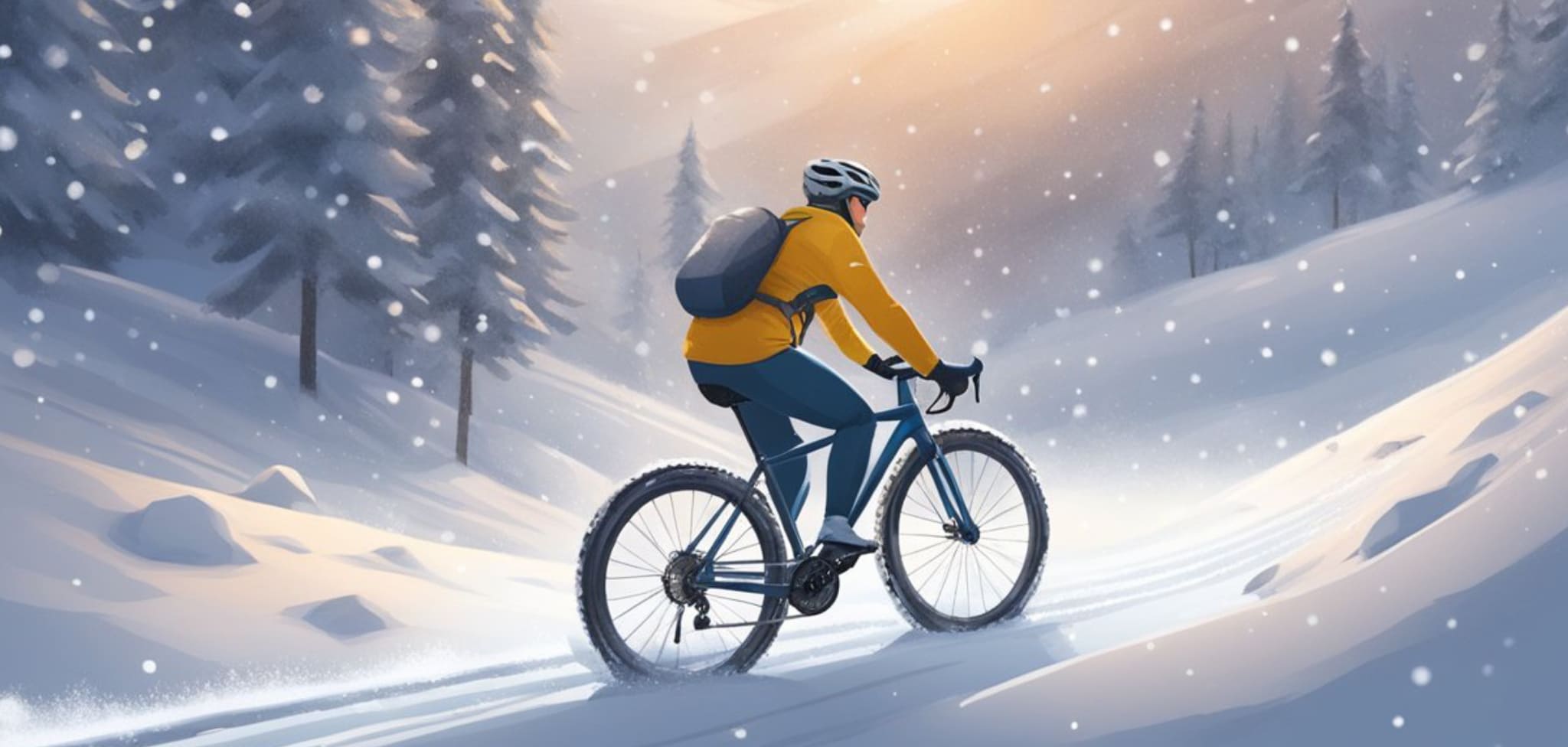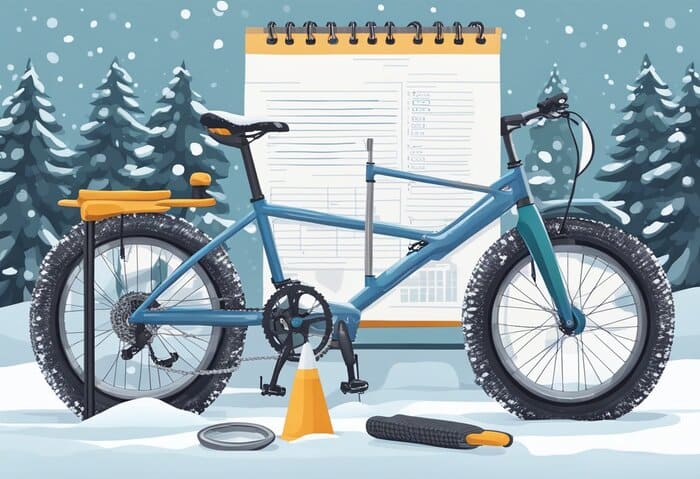Tips for Winter Cycling: Stay Warm and Safe on the Road
Winter can be a challenging time for cyclists, with cold temperatures, wet conditions, and shorter daylight hours. However, with the right preparation and mindset, winter riding can be highly rewarding. In this article, we will provide you with a comprehensive guide on how to stay warm, safe, and motivated during your winter cycling adventures. From layering your clothing to taking care of your bike and yourself, we’ve got you covered. So, let’s dive in!
Layer Up: Keep Your Core Toasty
When it comes to winter cycling clothing, layering is key. Start with a warm base layer that will keep your core temperature toasty. Your body makes decisions based on core temperatures, so it’s essential to keep your core warm. From there, you can add multiple layers that you can put on or take off as you get warmer or the ride gets longer. A good base layer and a jacket can get you through almost any winter conditions.
Remember, when you step outside, you shouldn’t feel warm right away. It’s normal to feel slightly cold before you start riding. If you’re warm when you begin your ride, you’re probably wearing too much clothing. Embrace the cold and let your body warm up naturally as you pedal.
Use Your Current Bike: No Need for a New One
You don’t necessarily need a new bike for winter riding unless you have specific requirements. Biking in winter can be rough on bikes, so it’s best to avoid risking damage to your primary ride. Instead, consider using that mountain bike collecting dust in your garage. Its wider tires and more stable frame will provide better traction on snow and ice. To increase stability, run the lowest tire pressure you can without getting a pinch flat. Experiment with tire pressure in the fall to find the optimal balance.
If you’re riding in icy conditions and want extra traction, investing in a pair of studded tires is worth considering. They provide additional grip on slippery surfaces, giving you more confidence on your rides.
Wash Your Bike Regularly: Protect it from Corrosion
Riding in slush and snow can kick up a lot of salty, dirty water onto your bike’s parts, leading to corrosion and damage over time. To prevent this, make sure to wash your bike after each ride. If you can’t do a full wash, at least wipe it down or rinse it to remove the debris. Avoid using WD-40 on your bike, as it’s not recommended. However, spraying it on the frame before a ride can help repel ice and grime kicked up by your tires.
After cleaning your bike, apply a thick lube like NixFrixShun to your chain to get rid of excess moisture. This will help keep everything running smoothly on your next frozen ride.
Don’t Neglect Your Extremities: Keep Your Hands and Feet Warm
Your hands and feet are the first to feel the cold during winter rides, as your body focuses on keeping your core warm. It’s crucial to keep your extremities toasty for an enjoyable winter cycling experience. Invest in a good pair of warm cycling gloves that provide insulation and protection against the cold. Air-activated heat packs can also be a game-changer. Slip them inside your gloves and shoes for extra warmth. Be sure to carry a few extra heat packs in case your riding buddies need them too.
In sub-freezing temperatures, winter cycling boots can make a significant difference in your comfort level. Consider investing in a pair like the Lake MXZ 304, designed specifically for cold conditions.
Pack Extra Gear: Be Prepared for Changing Conditions
Winter weather can be unpredictable, so it’s essential to be prepared for changing conditions during your ride. Pack extra gear to handle temperature shifts and unexpected situations. Carry two pairs of gloves—one heavier and one lighter—to adapt to varying temperatures. Lighter gloves offer better finger dexterity, making flat tire changes faster and easier. Stash an extra pair of wool socks in a resealable plastic bag in case your feet get wet. They can be a lifesaver if you accidentally step in a puddle or an icy stream.
Don’t Be Afraid to Use Other Sporting Equipment
If you’re already involved in other winter sports like skiing or snowboarding, there’s no need to buy a lot of new cycling gear. Ski gloves, for example, can keep you warm on the bike, although they may limit finger dexterity. Ski helmets can also provide better insulation than multi-vented bike helmets. Just be cautious not to overheat when wearing extra layers designed for other sports.
Insulate Your Liquids: Stay Hydrated and Warm
Staying hydrated is crucial, even during winter rides. While you may not feel warm on the bike, your body still sweats and loses fluids that need replenishing. To warm up from the inside out, bring hot broth or coffee in a double-insulated coffee mug or flask. This will keep your liquids hot, and in turn, keep you warm, even in freezing conditions. If you prefer using a traditional water bottle, keep it in your back jersey pocket to prevent freezing.
Ride with Fenders: Stay Dry and Keep Others Safe
Fenders are essential for winter riding as they keep slushy road spray off you and your bike. They also protect the people you ride with. Attach a pair of SKS Race Blades or a similar product to your bike to keep yourself and others clean and safe. If you’re not familiar with installing fenders, our handy guide can help you choose and install the right one for your bike.
Tire Studs
Winter roads can be slippery and icy, and tire studs can provide extra traction and stability. Tire studs are small metal spikes that are embedded in the tire tread, providing grip on icy surfaces. Cyclists can choose between studded tires or tire studs that can be attached to regular tires. However, it’s important to note that tire studs can be noisy and wear out quickly on dry roads.
Tire Pressure Check
Cold weather can cause your bike’s tires to lose air pressure, so it’s important to check your tire pressure regularly. Use a tire pressure gauge to ensure that your tires are properly inflated. Overinflated tires can be just as dangerous as underinflated tires, so be sure to check your tire pressure regularly.
Stay Visible: Be Seen and Stay Safe
Daylight is scarce during winter months, making road safety a top priority. Always use lights when riding in low-light conditions. Position your lights correctly to illuminate yourself and the road ahead. Flashing bike lights can help increase visibility, but be considerate of other road users. Take up the primary position on the road to command your space and give yourself room in case drivers behind you fail to notice you.
When riding in winter, it’s important to anticipate other road users’ behavior. Catch the driver’s eye whenever possible, as eye contact is an effective form of communication. Be cautious of leaf-strewn areas, as wet leaves can create slippery surfaces. If riding in a group, maintain a safe distance from the person in front and anticipate potential hazards ahead.
Protect Your Skin: Apply Sunscreen and Moisturize
Even in winter, it’s crucial to protect your skin from UV radiation and dryness. Apply sunscreen to any exposed skin, especially your face, when riding during the day. Snow can reflect nearly 90 percent of UV radiation, increasing the risk of sunburn. Additionally, cycling in winter can dry out your skin, so applying a moisturizer or even Vaseline can help retain moisture. Don’t forget to protect your lips with lip balm as well.
Safety Tips
When bicycling in winter, safety should be a top priority. The following tips can help riders stay safe on the road.
Riding Techniques
Riding techniques can help riders maintain control of their bike in winter conditions. Riders should:
- Brake gently to avoid skidding on icy patches.
- Avoid sudden turns or movements that can cause a loss of balance.
- Slow down when approaching corners or intersections.
- Keep a safe distance from other vehicles on the road.
- Use hand signals to indicate turns or stops.
Route Planning
Route planning can help riders avoid dangerous road conditions. Riders should:
- Plan their route ahead of time to avoid roads with heavy traffic or poor road conditions.
- Check the weather and road conditions before heading out.
- Choose well-lit roads with good visibility.
- Avoid roads with steep hills or sharp turns.
- Consider riding on a bike path or trail instead of on the road.
Emergency Preparedness
Emergency preparedness can help riders handle unexpected situations. Riders should:
- Carry a fully charged cell phone in case of emergency.
- Bring a repair kit and extra clothing in case of a breakdown or unexpected weather changes.
- Wear reflective clothing to increase visibility.
- Consider taking a first aid course to be prepared for emergencies.
- Tell someone where they are going and when they expect to return.
By following these safety tips, riders can enjoy bicycling in winter while minimizing the risk of accidents or injuries.
Benefits of Winter Bicycling
Winter bicycling is a great way to stay active and healthy during the colder months of the year. In addition to the physical benefits, winter bicycling can also have a positive impact on mental health and the environment. Here are some of the benefits of winter bicycling:
Fitness
Bicycling is a great way to stay in shape, winter bicycling helps improve cardiovascular fitness, build endurance, and increase muscle strength. Riding in cold weather can also burn more calories than riding in warmer temperatures, as the body works harder to maintain its core temperature.
Mental Health
Winter bicycling can have a positive impact on mental health. exercising in nature can improve mental health by reducing anxiety and combating a depressive mood. Winter bicycling can also be a great way to clear the mind and reduce stress.
Environment Friendly
Winter bicycling is an environmentally friendly mode of transportation. bicycling produces zero emissions and helps reduce traffic congestion and air pollution. By choosing to ride a bike instead of driving a car, individuals can help reduce their carbon footprint and contribute to a cleaner, healthier environment.
Stay Motivated: Beat the Winter Blues and Keep Riding
Winter can be a challenging time to stay motivated, but with the right mindset, you can conquer the winter blues and keep riding. Anticipate the challenges and embrace them. Prepare your gear the night before to make it easier to get out the door. If you’re not feeling like riding, give it 10 minutes and see if your mood changes. Often, once you’re on the bike, you’ll feel good and want to keep going.
If you struggle with Seasonal Affective Disorder (SAD) or winter blues, take steps to combat it. Lack of light is a common cause, so sleep with your curtains open or invest in a dawn-simulating alarm clock. Try to exercise during daylight hours to increase your exposure to natural light. Joining club rides or spin classes can also boost motivation and provide social contact, which can help prevent down periods. Additionally, consider seeking professional help if needed.
Stay Active: Embrace Indoor Training and Off-Bike Activities
Winter is a great time to focus on indoor training and off-bike activities that can complement your cycling. Invest in a smart trainer to make indoor rides more enjoyable. Apps like Zwift can make your indoor training sessions feel like a virtual world, allowing you to compete with friends and strangers. You can also try apps like TrainerRoad for structured workouts.
Heading to the gym during winter can be a productive way to stay active and strengthen your body. Incorporating weight training, especially exercises like squats and deadlifts, can improve your overall strength and endurance on the bike. Remember to take regular rest days to allow your body to recover and improve.
Conclusion
Winter cycling may present its challenges, but with the right preparation and mindset, it can be a rewarding and enjoyable experience. Layer up to keep your core warm, use your current bike with appropriate tires, and wash your bike regularly to prevent corrosion. Don’t forget to protect your extremities with warm gloves and winter cycling boots. Pack extra gear, such as gloves and socks, to handle changing conditions. Stay visible on the road with lights, fenders, and reflective clothing. Protect your skin from UV radiation and dryness, and stay motivated by beating the winter blues. Finally, embrace indoor training and off-bike activities to complement your winter riding.
So, gear up, stay warm, and enjoy the beauty of winter cycling!
Frequently Asked Questions
What are the best winter bike accessories?
There are several winter bike accessories that can make your ride more comfortable and safe. Some of the popular accessories include fenders to keep snow and slush from spraying up onto you and your bike, lights to increase visibility during shorter daylight hours, and a bike cover to protect your bike from the elements when not in use. Other useful accessories include a handlebar bag or panniers to carry extra layers, gloves, and snacks.
What is the best winter biking gear?
The best winter biking gear depends on the weather conditions you’ll be riding in. However, some essential gear includes a windproof and waterproof jacket, a base layer that wicks away sweat, and warm tights or pants. A balaclava or neck warmer, gloves and warm socks are also important to keep extremities warm. Additionally, cycling shoes with a stiff sole and good tread can provide better traction in slippery conditions.
What are the must-haves for winter cycling?
The must-haves for winter cycling include warm and waterproof clothing, good lighting, and reliable brakes. It’s also important to have a bike that’s in good working condition, with tires that have good tread and are properly inflated. Carrying a repair kit, pump, and extra inner tubes can also be helpful in case of a flat tire.
What are the best winter bikes for commuting?
The best winter bikes for commuting are those that have wider tires with good tread for better traction on snow and ice. Bikes with internal gear hubs and disc brakes can also be more reliable in wet and snowy conditions. Commuter bikes with fenders and racks for carrying gear can also be useful.
What are the best winter cycling gloves?
The best winter cycling gloves are those that are warm, waterproof, and windproof. Look for gloves with insulation and a waterproof and breathable membrane. Gloves with a longer cuff can also help keep wrists and forearms warm.
Is it safe to bike in the snow?
Biking in the snow can be safe as long as you take the proper precautions. It’s important to have good lighting and reflective gear to increase visibility, as well as wider tires with good tread for better traction. Riding at a slower pace and allowing more time to stop can also help prevent accidents. It’s also important to dress appropriately for the weather and to avoid riding in extreme conditions, such as during a blizzard or ice storm.
RECENT POSTS
History of Baseball
History of Baseball: From Its Origins to Modern TimesBaseball is one of the most popular sports in the United States, with millions of fans tuning in to watch games each year. The sport has a [...]
Hunting Falconry
History of Hunting Falconry: An Overview of Falconry's Evolution and Significance Are you interested in learning about the ancient practice of hunting with trained birds of prey? Falconry has been practiced for thousands of [...]
Hunting Destinations in 2024
Hunting Destinations in 2024: Top Picks for Avid Hunters Are you looking for exciting hunting destinations to explore in 2024? Whether you're a seasoned hunter or just starting, there are plenty of options available [...]
History of hunting dogs
Explore the History and Significance of Hunting Dogs: A Comprehensive Guide If you're a hunting enthusiast, then you know the importance of having a reliable hunting dog by your side. Hunting dogs have been [...]
Hunting as a Hobby
Hunting as a Hobby: An Overview Hunting is a popular outdoor activity enjoyed by millions of people worldwide. While some hunt for food, others do it as a hobby. Hunting as a hobby can [...]












